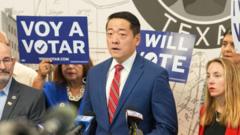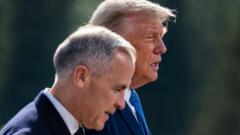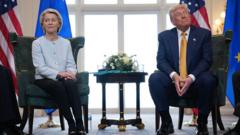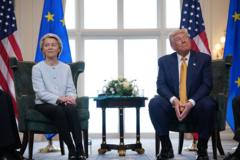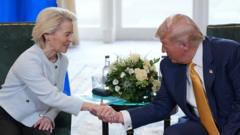Fact-checking the claims made in the Oval Office meeting reveals a stark contrast between rhetoric and reality, especially on the subject of violence against white farmers in South Africa.
Trump and Ramaphosa’s Oval Office Dispute Debunked: A Deep Dive into the Facts

Trump and Ramaphosa’s Oval Office Dispute Debunked: A Deep Dive into the Facts
A tense exchange between Trump and South Africa's president raises questions on claims related to agricultural violence.
In a recent Oval Office meeting, former President Donald Trump confronted South African President Cyril Ramaphosa over contentious assertions about violence against white farmers in South Africa. What began as a cordial meeting quickly evolved into a tense exchange, highlighted by Trump's insistence on presenting dubious evidence to support his claims.
Trump requested his staff to display a video clip featuring South African opposition politicians calling for violence against white farmers, alongside footage he claimed showed mass graves of farmers. "These are burial sites right here. Burial sites. Over a thousand of white farmers," Trump remarked while displaying images of white crosses along a rural road. However, these crosses are not grave markers; they were erected as a temporary memorial for Glen and Vida Rafferty, a white farming couple murdered in 2020, according to event organizer Rob Hoatson.
Further scrutinizing Trump’s claims, he insinuated a "genocide" against white farmers in South Africa. While the nation grapples with a high murder rate, official data from the South African Police Service (SAPS) indicates that the number of farmers killed last year is considerably lower than Trump's alarming assertions. Specifically, out of 26,232 murders, only 44 occurred within the farming community, and the mortality statistics did not indicate a racially targeted genocide. A South African judge previously dismissed the notion of genocide as "clearly imagined," underscoring the lack of substantial evidence to support such claims.
The meeting also featured footage of political rallies where attendees sang "Kill the Boer," a song deemed hate speech by some courts. Trump attributed the rallying cries to government officials, but many figures like Julius Malema, who led the song, have never held an official government position. Ramaphosa responded firmly, stating that Malema's party, the Economic Freedom Fighters (EFF), represents a small minority and does not align with government policy.
Trump also showcased a series of articles he claimed illustrated white farmer killings. However, one of the images displayed was misidentified; it depicted a different context entirely, unrelated to South Africa, and originated from a report on violence against women in the Democratic Republic of Congo.
The Exchange in the Oval Office exemplifies how historical complexities surrounding race and land ownership are often oversimplified within political narratives. As fact-checking continues to unveil the discrepancies in these claims, the dialogue underscores the importance of relying on verifiable data over anecdotal evidence in discussions of such sensitive societal issues.


